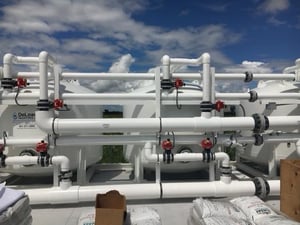 The Term referred to as “Degasification” or "Decarbonation" and how they work
The Term referred to as “Degasification” or "Decarbonation" and how they work
Relates to the process of the removal of suspended gas or solids that are converted to a gas-based upon certain criteria during water filtration, treatment, membrane filtration, or attempting to adjust pH. When removing (CO2) the process is often referred to as “Decarbonation”, when removing (H2S) the process is often referred to as “Degasification”.
Degasification is the most economical method for
the removal of Hydrogen Sulfide (H2S), Carbon Dioxide (CO2), and Oxygen (02) can all be removed by “Degasification”. The other variables are the total inlet water flow rate, the inlet feed temperature of the water, the ambient air temperature, the inlet concentrations that can be expressed as parts per billion (ppb), parts per million (ppm) or Mg/l, and the desired effluent removal levels also expressed in the same method. It is also important to fully understand the actual application and the use of the water to determine how critical maintaining critical levels are and what impact variations will create for the final use. Understanding these variables will aid you in the design of the system and any additional redundant systems needed to assure full compliance with standards.
Reverse Osmosis is often followed by
“Degasification” to remove the remaining dissolved gases such as Hydrogen Sulfide (H2S) or Carbon Dioxide (CO2). Membrane filtration utilizes the process of degasification to remove the dissolved (H2S) and (CO2) gas remaining in the permeate water prior to chlorination to reduce the amount of chlorine required to maintain a residual level and to improve TSS (Total suspended solids) levels. Other times the degasification process is used to remove (CO2) to raise the pH without the need of additional chemicals added to the water to help create a neutral level.
Post-treatment of the airflow
from a degasification or decarbonation tower can be required if the (H2S) levels are high enough to create either an odor nuisance or a harmful off-gas environment. A degasification tower that is being utilized in a steam process prior to a boiler feed system may be located where other workers will be exposed to the off-gases creating a potentially harmful working environment. In addition, if the gases are left untreated they often create a very corrosive environment for all surrounding equipment. The (H2S) combined with water vapor or moisture will create sulfuric acid and cause corrosion on surrounding metal exteriors just as the (H2S) if left in the water will cause corrosion inside a steam boiler system. There are many types of odor control or air emission scrubbers available that attach to the off-gas system of the degasifier or decarbonator. Click the link to learn more about Industrial Water Treatment. For more information or to learn more contact the professionals at DeLoach Industries Inc. at (941) 371-4995.
Receive our Free Odor Control E-book




